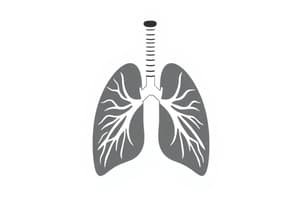Podcast
Questions and Answers
Inhalation occurs when the:
Inhalation occurs when the:
- Diaphragm ascends and the intercostal muscles contract, causing a decrease in intrathoracic pressure.
- Diaphragm and intercostal muscles relax and cause an increase in intrathoracic pressure.
- Diaphragm and intercostal muscles contract and cause a decrease in intrathoracic pressure. (correct)
- Diaphragm and intercostal muscles ascend and cause an increase in intrathoracic pressure.
The leaf-shaped structure located superior to the larynx is called the:
The leaf-shaped structure located superior to the larynx is called the:
- Epiglottis (correct)
- Cricoid ring
- Thyroid cartilage
- Vallecula
A patient who is suspected of being hypoxic and is breathing adequately should be given supplemental oxygen with a:
A patient who is suspected of being hypoxic and is breathing adequately should be given supplemental oxygen with a:
- Nonrebreathing mask (correct)
- Bag-valve mask device
- Nasal cannula
- Pocket facemask device
A 19-year-old female is found unconscious by her roommate. Your initial assessment reveals that her breathing is inadequate. As you insert an oropharyngeal airway, she begins to gag violently. You should:
A 19-year-old female is found unconscious by her roommate. Your initial assessment reveals that her breathing is inadequate. As you insert an oropharyngeal airway, she begins to gag violently. You should:
Structures of the lower airway include all of the following, EXCEPT the:
Structures of the lower airway include all of the following, EXCEPT the:
The nasopharyngeal airway is MOST beneficial because it:
The nasopharyngeal airway is MOST beneficial because it:
The actual exchange of oxygen and carbon dioxide occurs in the:
The actual exchange of oxygen and carbon dioxide occurs in the:
Gas exchange in the lungs is facilitated by:
Gas exchange in the lungs is facilitated by:
While eating dinner, your partner suddenly grabs his throat and has a panicked look on his face. He has a weak cough, faint inspiratory stridor, and cyanosis around the lips. You should:
While eating dinner, your partner suddenly grabs his throat and has a panicked look on his face. He has a weak cough, faint inspiratory stridor, and cyanosis around the lips. You should:
The nasal cannula is MOST appropriately used in the prehospital setting:
The nasal cannula is MOST appropriately used in the prehospital setting:
Which of the following structures is NOT found in the upper airway?
Which of the following structures is NOT found in the upper airway?
You are performing mouth-to-mask ventilations with oxygen connected and set at a flow rate of 15 liters per minute. What percentage of oxygen is your patient receiving?
You are performing mouth-to-mask ventilations with oxygen connected and set at a flow rate of 15 liters per minute. What percentage of oxygen is your patient receiving?
With a good mask-to-face seal and an oxygen flow rate of 15 L/min, the nonrebreathing mask is capable of delivering up to ____% oxygen.
With a good mask-to-face seal and an oxygen flow rate of 15 L/min, the nonrebreathing mask is capable of delivering up to ____% oxygen.
Irregular respirations characterized by an increasing rate and depth of breathing followed by periods of apnea are called:
Irregular respirations characterized by an increasing rate and depth of breathing followed by periods of apnea are called:
Which of the following statements regarding the one-person bag-valve mask (BVM) device is correct?
Which of the following statements regarding the one-person bag-valve mask (BVM) device is correct?
All of the following will help minimize the risk of gastric distention when ventilating an apneic patient with a BVM device, EXCEPT:
All of the following will help minimize the risk of gastric distention when ventilating an apneic patient with a BVM device, EXCEPT:
Which of the following factors will MOST likely cause a decreased minute volume in the adult?
Which of the following factors will MOST likely cause a decreased minute volume in the adult?
Which of the following statements regarding breathing adequacy is correct?
Which of the following statements regarding breathing adequacy is correct?
In contrast to inhalation, exhalation:
In contrast to inhalation, exhalation:
What occurs when a patient is breathing very rapidly and shallowly?
What occurs when a patient is breathing very rapidly and shallowly?
A 71-year-old male is semiconscious following a sudden, severe headache. There is vomitus on his face and he is breathing with slow, shallow respirations. The MOST appropriate initial airway management for this patient is to:
A 71-year-old male is semiconscious following a sudden, severe headache. There is vomitus on his face and he is breathing with slow, shallow respirations. The MOST appropriate initial airway management for this patient is to:
Of the 21% room air oxygen that a person inhales, approximately ___% is exhaled.
Of the 21% room air oxygen that a person inhales, approximately ___% is exhaled.
Which of the following body systems can survive the longest period of time without oxygen?
Which of the following body systems can survive the longest period of time without oxygen?
A nasopharyngeal airway is inserted:
A nasopharyngeal airway is inserted:
The diaphragm does NOT function as a voluntary muscle when a person:
The diaphragm does NOT function as a voluntary muscle when a person:
The severity of hypoxia depends MOSTLY on the patient's:
The severity of hypoxia depends MOSTLY on the patient's:
Each cell of the body combines nutrients and oxygen and produces energy and waste products through a process called:
Each cell of the body combines nutrients and oxygen and produces energy and waste products through a process called:
A 51-year-old female presents with a sudden onset of difficulty breathing. She is conscious and alert and able to speak in complete sentences. Her respirations are 24 breaths/min and regular. You should:
A 51-year-old female presents with a sudden onset of difficulty breathing. She is conscious and alert and able to speak in complete sentences. Her respirations are 24 breaths/min and regular. You should:
Prior to applying a nonrebreathing mask on a patient, you must ensure that the:
Prior to applying a nonrebreathing mask on a patient, you must ensure that the:
The exchange of air between the lungs and the environment is called:
The exchange of air between the lungs and the environment is called:
The MOST common and significant complication of using a flow-restricted oxygen-powered ventilation device is:
The MOST common and significant complication of using a flow-restricted oxygen-powered ventilation device is:
The MOST significant complication associated with oropharyngeal suctioning is:
The MOST significant complication associated with oropharyngeal suctioning is:
On which of the following patients would it be MOST appropriate to use the flow-restricted oxygen-powered ventilation device?
On which of the following patients would it be MOST appropriate to use the flow-restricted oxygen-powered ventilation device?
Which of the following structures is/are contained within the mediastinum?
Which of the following structures is/are contained within the mediastinum?
You are ventilating a patient with a stoma; however, air is escaping from the mouth and nose. To prevent this, you should:
You are ventilating a patient with a stoma; however, air is escaping from the mouth and nose. To prevent this, you should:
A 23-year-old male experienced severe head trauma after his motorcycle collided with an oncoming truck. He is unconscious, has rapid and shallow breathing, and is producing copious bloody secretions from his mouth. How should you manage his airway?
A 23-year-old male experienced severe head trauma after his motorcycle collided with an oncoming truck. He is unconscious, has rapid and shallow breathing, and is producing copious bloody secretions from his mouth. How should you manage his airway?
You are dispatched to a residence where a middle-aged man was found unconscious in his front yard. There are no witnesses that can tell you what happened. You find him in a prone position; his eyes are closed and he is not moving. Your FIRST action should be:
You are dispatched to a residence where a middle-aged man was found unconscious in his front yard. There are no witnesses that can tell you what happened. You find him in a prone position; his eyes are closed and he is not moving. Your FIRST action should be:
The purpose of the pin-indexing system that has been established for compressed gas cylinders is to:
The purpose of the pin-indexing system that has been established for compressed gas cylinders is to:
The hypoxic drive, the primary stimulus to breathe for patients with certain chronic respiratory diseases, is influenced by:
The hypoxic drive, the primary stimulus to breathe for patients with certain chronic respiratory diseases, is influenced by:
When testing a mechanical suctioning unit, you should turn on the device, clamp the tubing, and ensure that it generates a vacuum pressure of more than:
When testing a mechanical suctioning unit, you should turn on the device, clamp the tubing, and ensure that it generates a vacuum pressure of more than:
As the single EMT-B managing an apneic patient's airway, the preferred initial method of providing ventilations is the:
As the single EMT-B managing an apneic patient's airway, the preferred initial method of providing ventilations is the:
Which of the following patients should you place in the recovery position?
Which of the following patients should you place in the recovery position?
Which of the following oxygen flowmeters is NOT affected by gravity and can be used in any position when attached to an oxygen cylinder?
Which of the following oxygen flowmeters is NOT affected by gravity and can be used in any position when attached to an oxygen cylinder?
Which of the following patients would MOST likely require insertion of an oropharyngeal airway?
Which of the following patients would MOST likely require insertion of an oropharyngeal airway?
To select the proper size oropharyngeal airway, you should measure from the:
To select the proper size oropharyngeal airway, you should measure from the:
The ________ cartilage is a firm ring that forms the inferior part of the larynx.
The ________ cartilage is a firm ring that forms the inferior part of the larynx.
Which of the following will MOST likely occur if the body is deprived of oxygen for less than 2 minutes?
Which of the following will MOST likely occur if the body is deprived of oxygen for less than 2 minutes?
An oxygen cylinder should be taken out of service and refilled when the pressure inside it is less than:
An oxygen cylinder should be taken out of service and refilled when the pressure inside it is less than:
Proper technique for suctioning the oropharynx of an adult patient includes:
Proper technique for suctioning the oropharynx of an adult patient includes:
What is the minute volume of a patient with a tidal volume of 350 mL and a respiratory rate of 22 breaths/min?
What is the minute volume of a patient with a tidal volume of 350 mL and a respiratory rate of 22 breaths/min?
Flashcards are hidden until you start studying
Study Notes
Inhalation and Exhalation
- Inhalation involves diaphragm and intercostal muscles contracting, creating negative pressure in the thoracic cavity to draw air in.
- Exhalation is primarily passive, reliant on elastic recoil of the lungs and increased intrathoracic pressure.
Airway Structures
- The epiglottis is a crucial structure that prevents food from entering the airway during swallowing.
- The lower airway consists of the larynx, trachea, and alveoli, excluding the pharynx.
Oxygen Delivery Methods
- A nonrebreathing mask is the most effective for delivering supplemental oxygen to hypoxic patients, providing high oxygen concentration.
- Nasal cannulas are better suited for patients who cannot tolerate masks or require long-term oxygen.
Airway Management Techniques
- Inserting an oropharyngeal airway may trigger a gag reflex in unconscious patients; suctioning may be needed to clear secretions.
- Nasopharyngeal airways are more tolerated in conscious patients with intact gag reflexes, useful for those with potential airway obstruction.
Gas Exchange
- Actual gas exchange occurs in the alveolar sacs, where oxygen and carbon dioxide are exchanged.
- Surfactant in the alveoli is essential for efficient gas exchange, reducing surface tension and preventing lung collapse.
Emergency Situations
- In cases of choking, abdominal thrusts are recommended for conscious patients; back blows can be delivered to infants.
- A patient with slow, shallow breathing may require airway suctioning and ventilation support.
Respiratory Parameters
- Minute volume, the product of tidal volume and respiratory rate, indicates the amount of air exchanged per minute.
- A patient with increasing respiratory rate but shallow breathing will primarily ventilate dead space, limiting effective gas exchange.
Ventilation Devices
- The bag-valve mask (BVM) provides effective tidal volume and oxygen concentration but may require a proper face seal to minimize gastric distention.
- Oropharyngeal suctioning should be done cautiously to avoid hypoxia; suctioning while withdrawing from the airway is recommended.
Measurements and Techniques
- Proper sizing for oropharyngeal airways involves measuring from the corner of the mouth to the earlobe.
- A pressure of less than 500 psi indicates that an oxygen cylinder should be refilled.
Risk and Complications
- Gastric distention is a common complication of positive pressure ventilation; techniques should be employed to minimize this.
- The duration of oxygen deprivation leads to varied outcomes; less than 2 minutes can lead to cardiac irritability, while longer durations risk irreversible brain damage.
Special Considerations
- Patients with altered mental status and reduced tidal volume, such as those overdosing, may need specific positioning for airway protection.
- Gravity-affected flowmeters must be selected appropriately based on the positioning of an oxygen cylinder in use.
These notes cover critical aspects and management of respiratory scenarios, focusing on both anatomical and clinical considerations.
Studying That Suits You
Use AI to generate personalized quizzes and flashcards to suit your learning preferences.





